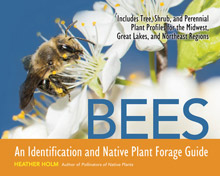When it comes to native plants, I like them all! From the Wild Ginger (
Asarum canadense), for which you have to get down on your hands and knees in order to appreciate its lovely three-petalled maroon flower – to the lofty Flat-topped Aster (
Doellingeria umbellata) with its clusters of white-petalled flowers set off by yellow centre disks, making for a creamy effect.
But I do have favourites. And I also have reservations.
The number one example of qualified affection comes with the spiderwort. The species I have is
Tradescantia ohiensis; like others in the genus, the flower has three petals and opens early in the day, closing by around noon. Ohio Spiderwort is a wonderful deep blue with six bright yellow anthers (those are the pollen-bearing parts of the stamens) and strappy blue-green leaves. When visited by a brightly coloured bee (I believe the
Agapostemon virescens is the one in the photo below), the effect is deeply satisfying.
Read more



















